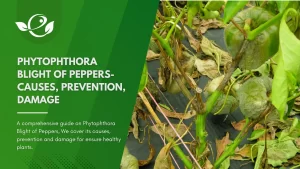Table of Contents
Healthy plants rely on a delicate balance of essential nutrients to grow, thrive, and produce abundant yields. Among these nutrients, calcium plays a critical role in forming sturdy cell walls, promoting root development, and ensuring overall plant vitality. However, calcium deficiency is a common challenge faced by gardeners and farmers alike, manifesting as weak stems, distorted leaves, or poor fruit development.
The good news is that calcium deficiencies can be managed effectively with the right knowledge and tools. This article delves deep into understanding calcium deficiency in plants—its symptoms, causes, diagnosis, and actionable strategies for fixing and preventing the issue. Whether you’re tending to a vegetable garden, a greenhouse, or a field of crops, these insights will empower you to maintain healthier, more resilient plants.
Symptoms of Calcium Deficiency in Plants
Calcium deficiency manifests uniquely in various plant parts, primarily affecting rapidly growing tissues due to calcium’s limited mobility in plants. Understanding these symptoms is essential for early intervention.
A. Symptoms in Leaves
- Young Leaves:
- Tip Burn: Leaf tips turn brown and necrotic, a hallmark symptom.
- Curling: Leaves may curl or become distorted due to weak cell walls.
- Chlorosis: Interveinal chlorosis (yellowing between leaf veins) can occur, primarily in new growth.
- Older Leaves: Generally unaffected because calcium does not move from old to new tissues.
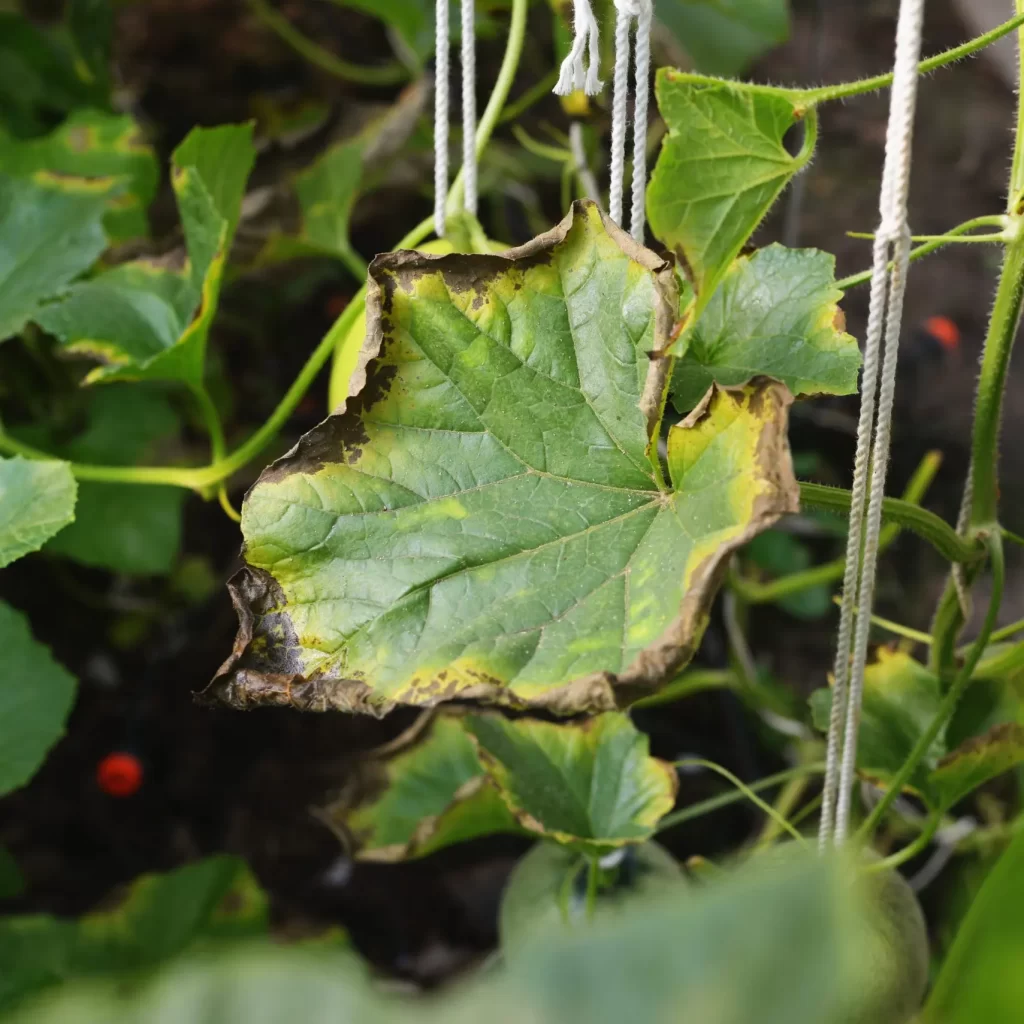
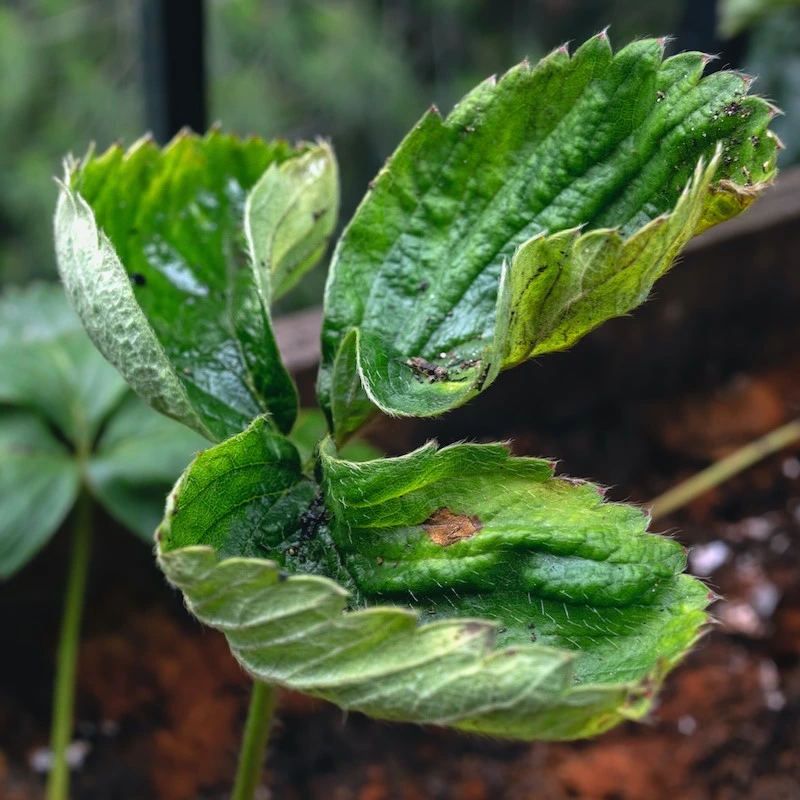
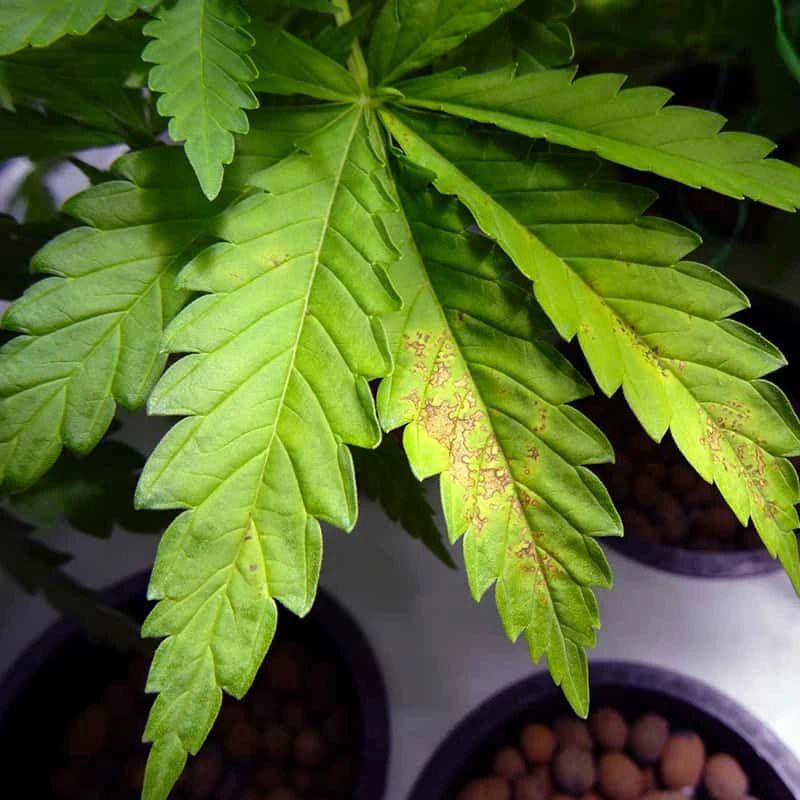
B. Symptoms in Fruits
- Blossom End Rot:
- Affects fruits like tomatoes, peppers, and zucchinis.
- Soft, water-soaked spots develop on the blossom end of the fruit, which later turn brown or black.
- Fruit Cracking and Misshapen Growth:
- In apples, cork-like spots (bitter pit) may develop.
- Irregular fruit shapes result from poor cellular development.

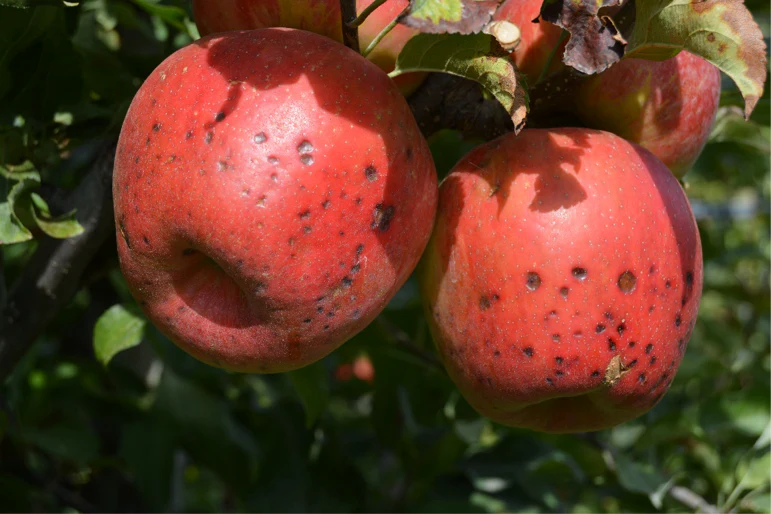

C. Symptoms in Stems
- Stems may bend or collapse under the plant’s weight.
- Lack of structural support increases susceptibility to mechanical damage.


D. Symptoms in Roots
- Underdeveloped Roots:
- Roots appear thin, short, or poorly branched.
- The plant struggles to anchor itself, leading to poor nutrient and water absorption.
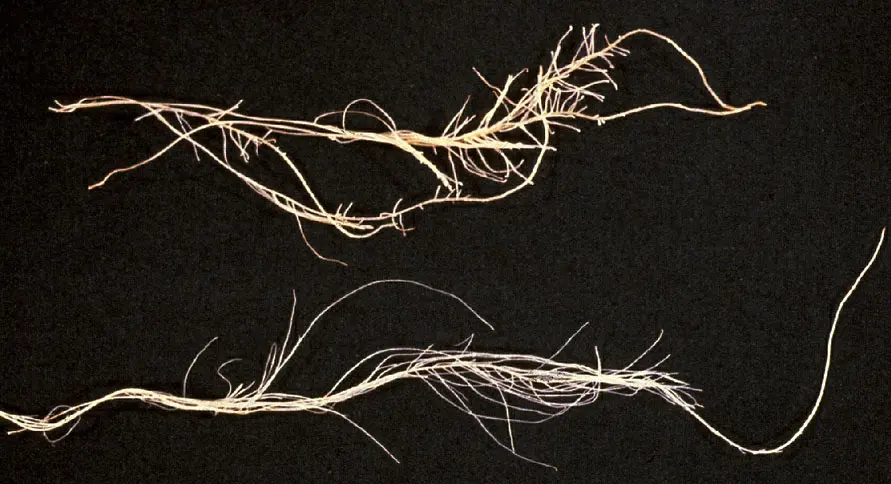

E. Symptoms in Flowers
- Flowers may fail to develop fully, with petal tips browning or dropping prematurely. This often results in poor fruit set or low yield.
Additional Tips for Symptom Identification:
- Inspect new growth first, as symptoms appear there earliest.
- Differentiate calcium deficiency from nutrient toxicities or other deficiencies by considering accompanying soil or environmental factors.
Causes of Calcium Deficiency
The underlying causes of calcium deficiency often involve soil, water, or environmental conditions. Addressing these factors ensures long-term solutions rather than temporary fixes.
A. Soil Factors
- Low pH (Acidic Soil):
- Acidic soils bind calcium ions, reducing their availability to plants.
- Aluminum toxicity, common in acidic soils, can also hinder calcium uptake.
- Nutrient Imbalances:
- High levels of magnesium, potassium, or sodium compete with calcium for uptake.
- Over-fertilization with ammonium-based fertilizers acidifies the soil, reducing calcium accessibility.
- Calcium Leaching:
- In sandy or well-drained soils, excessive rain or irrigation washes calcium away from the root zone.
B. Watering Practices
- Overwatering:
- Leads to waterlogged soil, suffocating roots and disrupting nutrient absorption.
- Leaches calcium out of the soil.
- Irregular Watering:
- Drought stress interrupts calcium movement to growing tissues, as calcium transport relies on transpiration.
C. Environmental Conditions
- High Humidity:
- Reduces transpiration, limiting calcium transport from roots to above-ground tissues.
- Common in greenhouse settings or during prolonged rainy periods.
- Temperature Extremes:
- Heat stress increases calcium demand but can simultaneously reduce availability.
- Cold soils slow root activity, limiting calcium uptake.
D. Plant-Specific Factors
- High Calcium Demand: Crops like tomatoes, peppers, and strawberries require significant calcium, depleting soil reserves quickly.
- Rapid Growth Rates: Fast-growing plants outpace calcium availability, particularly in nutrient-poor soils.
E. Compaction and Poor Drainage
- Compacted soil restricts root expansion and prevents effective nutrient absorption.
- Poor drainage leads to waterlogged conditions, causing root suffocation.
Diagnosis of Calcium Deficiency
Accurate diagnosis is key to applying the right corrective measures. Here’s a step-by-step guide to diagnosing calcium deficiency in plants:
A. Visual Inspection
- Symptoms in New Growth: Focus on young leaves and fruits for early signs like tip burn or blossom end rot.
- Rule Out Other Deficiencies:
- Nitrogen deficiency causes yellowing in older leaves, unlike calcium deficiency, which affects new growth.
- Magnesium deficiency causes interveinal chlorosis in older leaves, often mistaken for calcium issues.
- Consistent Patterns: Check for uniformity in symptoms across affected plants.
B. Soil Testing
- pH Testing:
- Use a soil pH meter or test kit to check if the pH is below 6.0, indicating acidic conditions.
- Amend soil accordingly (e.g., lime for acidic soils).
- Calcium Levels:
- Use lab testing or home test kits to measure available calcium.
- Recommended calcium levels: 1,000–2,000 ppm for most plants.
- CEC (Cation Exchange Capacity):
- Assess the soil’s ability to retain calcium and other nutrients.
C. Tissue Analysis
- Collect samples of young leaves and send them to a lab for precise nutrient profiling.
- Ideal for confirming calcium deficiency when soil tests are inconclusive.
D. Observation of Watering and Drainage
- Monitor Watering Practices: Assess if overwatering or inconsistent irrigation might be contributing to calcium issues.
- Check Drainage: Ensure soil is not waterlogged or compacted, as this prevents proper root function.
E. Environmental Analysis
- Humidity and Temperature:
- Review growing conditions, particularly in controlled environments like greenhouses.
- Use hygrometers and thermometers to measure and regulate humidity and temperature.
- Companion Crops: Evaluate if companion plants with high calcium demands are competing for nutrients.
Pro Tip: Use a combination of soil testing, tissue analysis, and environmental monitoring to confirm calcium deficiency.
Fixing Calcium Deficiency in Plants
Once you’ve identified calcium deficiency, the next step is to restore calcium levels in your soil or plants effectively. The solutions can be short-term fixes or long-term strategies, depending on the severity of the deficiency and the specific plant needs.
A. Adjusting Soil pH
- Use Lime for Acidic Soils:
- Agricultural Lime: Best for gradually raising soil pH and providing calcium over time.
- Dolomite Lime: Ideal if magnesium levels are also low, as it supplies both calcium and magnesium.
- How to Apply: Spread lime evenly over the soil and incorporate it with a tiller or hoe. Water thoroughly to activate it.
- Monitor Application Rates:
- Test soil to determine the exact amount needed.
- Typical application: 40-50 pounds per 1,000 square feet for moderately acidic soils.
- Timing: Apply lime in fall or early spring for the best results, as it takes time to adjust pH.
B. Adding Calcium to Soil
- Organic Options:
- Crushed Eggshells: Rich in calcium but decompose slowly. Best as a long-term amendment.
- Gypsum (Calcium Sulfate): Supplies calcium without altering soil pH, making it ideal for neutral or alkaline soils.
- Bone Meal: Provides calcium and phosphorus, excellent for flowering and fruiting plants.
- Inorganic Options:
- Calcium Nitrate: A quick-release fertilizer that provides calcium and nitrogen. Apply during the growing season for fast results.
- Calcium Chloride: Ideal for foliar sprays (see below).
- How to Apply:
- Mix the amendments into the top 6 inches of soil around plants.
- Water after application to help the calcium reach the root zone.
C. Foliar Sprays
- Why Foliar Sprays?
- Quick solution for acute calcium deficiencies, bypassing soil issues.
- Ideal during fruiting stages when calcium demand is high.
- How to Use:
- Mix calcium chloride or calcium nitrate with water (1 tablespoon per gallon).
- Spray on leaves in the early morning or late evening to avoid sunburn.
- Frequency: Repeat every 7-10 days until symptoms subside.
D. Improving Water Management
- Consistent Watering:
- Water plants deeply but less frequently to prevent calcium leaching.
- Maintain soil moisture evenly, particularly during hot weather.
- Improve Drainage:
- Incorporate organic matter like compost or mulch to enhance soil structure.
- Avoid compacted soils by aerating the soil regularly.
E. Companion Strategies
- Crop Rotation: Rotate calcium-demanding crops like tomatoes with less demanding plants to prevent nutrient depletion.
- Use Calcium-Enriched Fertilizers: Incorporate fertilizers labeled specifically for tomatoes or peppers that often include added calcium.
Preventing Calcium Deficiency
Prevention is key to ensuring long-term plant health. Regular maintenance and proactive measures help keep calcium levels balanced and prevent deficiencies from recurring.
A. Regular Soil Testing
- Annual Testing:
- Test soil at least once a year to monitor pH and calcium levels.
- Adjust pH or nutrient levels as needed.
- Calcium to Magnesium Ratio: Maintain a balanced ratio (ideally 3:1) for optimal nutrient availability.
B. Maintaining Optimal Soil Conditions
- Mulching:
- Apply organic mulch (e.g., straw, wood chips) to retain soil moisture and regulate temperature.
- Prevents soil compaction and nutrient runoff.
- Adding Organic Matter: Regularly incorporate compost, which improves soil structure and slow-releases calcium.
- Drainage Management: Ensure proper drainage by planting in raised beds or amending heavy clay soils with sand or organic matter.
C. Choosing the Right Fertilizers
- Calcium-Enriched Fertilizers: Use fertilizers designed for calcium-demanding plants, particularly during their fruiting stage.
- Avoid Excessive Nitrogen: High nitrogen levels can inhibit calcium uptake. Opt for balanced fertilizers instead.
D. Environmental Management
- Humidity Control: In greenhouses, use fans or dehumidifiers to maintain moderate humidity levels.
- Temperature Regulation: Protect plants from extreme temperatures by using shade cloths or row covers.
E. Strategic Crop Selection
- Calcium-Efficient Plants: Select varieties bred for high calcium efficiency if your soil is naturally deficient.
- Companion Planting: Grow complementary plants that do not overcompete for calcium, ensuring balanced nutrient uptake.
Common Myths About Calcium Deficiency
Misinformation about calcium deficiency can lead to wasted effort or worsening plant health. Here are some widespread myths and the facts behind them:
A. Myth: “All Soil Needs Lime.”
- Reality: Not all soils are acidic or require lime. Over-liming can lead to alkaline conditions, which inhibit nutrient availability.
- Tip: Always test soil pH before adding lime.
B. Myth: “Eggshells Alone Can Fix Calcium Deficiency.”
- Reality: While eggshells are a natural calcium source, they decompose very slowly, taking months or even years to release significant calcium.
- Tip: Use eggshells as part of a long-term soil improvement strategy, not a quick fix.
C. Myth: “Calcium Deficiency is Always a Soil Problem.”
- Reality: Deficiency often results from poor water management or environmental stress, even if the soil contains adequate calcium.
- Tip: Address irrigation practices and ensure consistent soil moisture.
D. Myth: “Adding More Fertilizer Will Fix It.”
- Reality: Over-fertilizing can create nutrient imbalances, making calcium less available to plants.
- Tip: Use targeted calcium amendments rather than general fertilizers.
You may also like:
- Boron deficiency in plants: Symptoms & Treatments
- How to Identify and Fix Iron Deficiency in Plants
- How to Fix Magnesium Deficiency in Plants: An Urgent Problem
- Phosphorus Deficiency Causes, Symptoms & Treatments
- Nitrogen Deficiency Symptoms and Treatment
Conclusion
Calcium is a cornerstone nutrient for plant health, influencing everything from growth to productivity. Addressing calcium deficiency begins with accurate identification, understanding the underlying causes, and implementing targeted corrective actions. Through soil amendments, proper watering techniques, and regular monitoring, you can ensure your plants receive the calcium they need to flourish.
Prevention, as always, is better than cure. By maintaining healthy soil conditions, using calcium-enriched fertilizers wisely, and staying informed about your plants’ needs, you can minimize the risk of deficiency altogether. Remember, small adjustments in your gardening practices can yield significant results in plant health and harvest quality.



